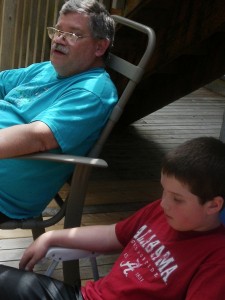Posts Tagged ‘George Washington’
» posted on Saturday, June 15th, 2024 by Linda Lou Burton
#1. Washington, George
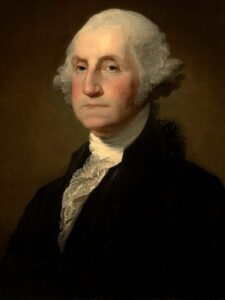 Linda Lou Burton posting from Little Rock, Arkansas – George Washington (February 22, 1732 – December 14, 1799) was red headed. Does that surprise you? The image in my mind when I hear the name “George Washington” is of a rather somber fellow with powdered-white hair. After all, that’s the picture hanging in almost every classroom in the United States. In truth, this red-headed fellow had sparkling grey-blue eyes, was more than six feet tall, and was known for his great strength. If George were alive today, you’d want him at your parties. He was a bit reserved, but had a strong presence and was well respected. He was rugged; he loved horses and collected thoroughbreds. He loved to hunt – foxes, deer, ducks and other game. But George was also an
Linda Lou Burton posting from Little Rock, Arkansas – George Washington (February 22, 1732 – December 14, 1799) was red headed. Does that surprise you? The image in my mind when I hear the name “George Washington” is of a rather somber fellow with powdered-white hair. After all, that’s the picture hanging in almost every classroom in the United States. In truth, this red-headed fellow had sparkling grey-blue eyes, was more than six feet tall, and was known for his great strength. If George were alive today, you’d want him at your parties. He was a bit reserved, but had a strong presence and was well respected. He was rugged; he loved horses and collected thoroughbreds. He loved to hunt – foxes, deer, ducks and other game. But George was also an 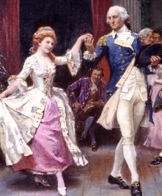 excellent dancer and loved the theater. He drank in moderation but opposed excessive drinking, smoking, gambling, and profanity.
excellent dancer and loved the theater. He drank in moderation but opposed excessive drinking, smoking, gambling, and profanity.
George was a good husband; when he married widow Martha Dandridge Custis in 1759 – he was 26, she was 27 – he assumed the role of husband, father to Martha’s two children Patsy and 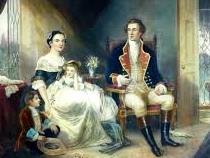 Jacky, and manager of Martha’s considerable estate. When Patsy died suddenly, George canceled all business dealings to stay by Martha’s side for three months. When Jacky died at the age of 26, George and Martha took in their grandchildren Nelly and Washy (George Washington Custis) and raised them. They never had children together, to the regret of both.
Jacky, and manager of Martha’s considerable estate. When Patsy died suddenly, George canceled all business dealings to stay by Martha’s side for three months. When Jacky died at the age of 26, George and Martha took in their grandchildren Nelly and Washy (George Washington Custis) and raised them. They never had children together, to the regret of both.
“Second shift” parenting was common at this point in history – one parent died, the other remarried, and children often grew up with half-siblings and a step-parent. Fortunes were gained through inheritance; land was the most desirable of assets. When George was born as the first child of Augustine and Mary Ball Washington in 1732, he had three older half-siblings from Augustine’s marriage to Jane Butler. Lawrence was 14, Augustine Jr was 12, and Jane was 10. George was just a year old when sister Betty was born; then Samuel, John Augustine, Charles, and Mildred by the time George was 7 years old. Augustine Washington was a prominent public figure; his own father had made a fortune in land speculation. When Augustine died in 1743, George, at the age of 11, inherited 10 slaves and Ferry Farm, near Fredericksburg, Virginia. Lawrence, age 25, inherited the land that became Mount Vernon.
George’s mother Mary never remarried, but chose to manage her land and raise her children on her own. She was unable to send George to school in England, where the older boys were educated; but George did learn mathematics, trigonometry, and land surveying and became a talented draftsman and map maker. George often visited Mount Vernon, and Belvoir, a plantation that belonged to Lawrence’s father-in-law William Fairfax. Fairfax became 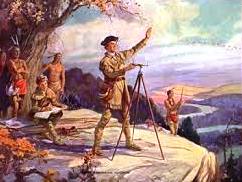 George’s patron; after George received a surveyor’s license from William & Mary College, Fairfax appointed him Surveyor of Culpepper County. George became familiar with the frontier region and by 1752, at the age of 20, had bought 1,500 acres in the Valley.
George’s patron; after George received a surveyor’s license from William & Mary College, Fairfax appointed him Surveyor of Culpepper County. George became familiar with the frontier region and by 1752, at the age of 20, had bought 1,500 acres in the Valley.
That’s how a career begins and a fortune builds; when Lawrence died George leased Mount Vernon from his widow; when she died he inherited the property. When George and Martha married in 1759 she and her children moved to Mount Vernon; it is where George died in 1799, and Martha in 1802; both are buried there. By occupation, George was a planter; he grew tobacco, wheat, and corn. He was counted among the social and political elite of Virginia; inviting guests to Mount Vernon; enjoying leisure time; and eventually becoming politically active.
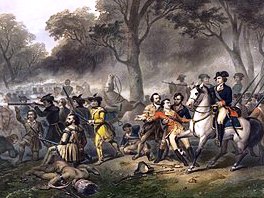 Lest George’s life sound too peaceful and laid back, there were a few other things going on. For instance, George had an unbelievable military career. He fought in a lot of battles! He had two horses shot out from under him in the same battle! He had bullet holes in his coat and hat! He was a fighter, and he never, ever gave up! George was a Colonel in the Colonial forces; General and Commander in Chief of the Continental Army, and a Lieutenant General in the US Army. We’re familiar with the famous Emanuel Leutze painting of Washington Crossing The Delaware; it would take a gallery to house portraits of all the battles he fought, in all the different campaigns. To name a few:
Lest George’s life sound too peaceful and laid back, there were a few other things going on. For instance, George had an unbelievable military career. He fought in a lot of battles! He had two horses shot out from under him in the same battle! He had bullet holes in his coat and hat! He was a fighter, and he never, ever gave up! George was a Colonel in the Colonial forces; General and Commander in Chief of the Continental Army, and a Lieutenant General in the US Army. We’re familiar with the famous Emanuel Leutze painting of Washington Crossing The Delaware; it would take a gallery to house portraits of all the battles he fought, in all the different campaigns. To name a few:
French and Indian War (1754-1763; George was 22-31): Battle of Jumonville Glen – Battle of Fort Necessity – Braddock Expedition – Battle of the Monongahela – Forbes Expedition
American Revolutionary War (1775-1783: George was 43-51): Boston campaign – New York and New Jersey campaign – Philadelphia campaign – Yorktown campaign
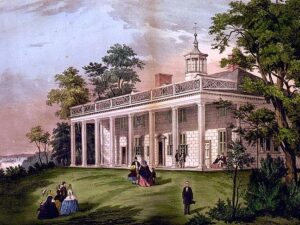 His military service took place before his marriage to Martha and during; when the Treaty of Paris was signed in Annapolis in 1783, and Great Britain officially recognized the independence of the United States, George resigned as Commander in Chief of the Continental Army with plans to retire to Mount Vernon, and a peaceful life with Martha.
His military service took place before his marriage to Martha and during; when the Treaty of Paris was signed in Annapolis in 1783, and Great Britain officially recognized the independence of the United States, George resigned as Commander in Chief of the Continental Army with plans to retire to Mount Vernon, and a peaceful life with Martha.
It didn’t turn out that way. Before he returned to private life, he called for a strong union, sending a letter to all states saying that the Articles of Confederation were no more than a “rope of sand” linking the states. He believed the nation was on the verge of anarchy and confusion, and that a national constitution unifying the states under a strong central government was essential. You know your history – a Constitutional Convention, delegates from all states convened in Philadelphia, a new constitution was called for; continued discussion and disagreement until finally, on February 4, 1789, the state electors voted for a president. There was no quorum present to count the votes until April 5; the next day the votes were tallied and Congressional Secretary Charles Thomson was sent to Mount Vernon to tell George he had won the majority of every state’s electoral votes. John Adams received the second highest vote count, so would be vice-president.
Just think – no campaigning, no national TV debating; and most interesting of all – no desire to BE president of this newly emerging entity called the “United States.” George admitted to “anxious and painful sensations” about leaving Mount Vernon, but departed for New York City on April 16 to be inaugurated. He took the oath of office at Federal Hall in New York City on April 30, 1789 at the age of 57. A crowd of 10,000 gathered; there was a parade complete with marching band, foreign dignitaries, and statesmen; the militia fired a 13-gun salute. George read a speech in the Senate Chamber, asking that “the Almighty Being who rules over the universe…consecrate the liberties and happiness of the people of the United States.”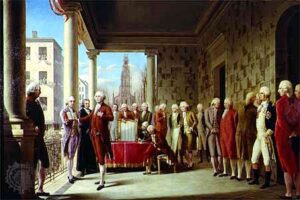
These essays are not about the presidency, but rather the road TO the presidency, and the type of person who won the attention of the electorate. George is unique in that he didn’t set out to “be” president; but he did establish many basic principles that are expected of a president today. For example, unlike the kingly rulers of European countries, George did not want to be called “His Excellency” or “His Highness.” “Mr President” was ample title for him. Other executive precedents included an inaugural address, messages to Congress, and the Cabinet form of management. He refused a salary for serving his country; Congress however insisted and provided him with $25,000 annually to help defray costs.
George was an able administrator and a good judge of talent and character. He talked regularly with department heads, tolerated opposing views, and conducted a smooth transition of power to his successor. He was apolitical and opposed the formation of parties. Although he owned slaves, and supported measures passed by Congress to protect slavery, he later became troubled with the institution of slavery and freed his slaves in a 1799 will, with the provision that the old and young freed people be taken care of indefinitely and the young taught to read and write and placed in suitable occupations. He endeavored to assimilate Native Americans into Anglo-American culture but combated indigenous resistance during instances of violent conflict. He urged broad religious freedom in his roles as general and president, emphasizing religious toleration in a nation with numerous denominations. He publicly attended services of different Christian denominations and prohibited anti-Catholic celebrations in the Army. He engaged workers at Mount Vernon without regard for religious belief or affiliation. He was rooted in the ideas, values, and modes of thinking of the Enlightenment, but harbored no contempt of organized Christianity and its clergy, “We have abundant reason to rejoice that in this Land the light of truth and reason has triumphed over 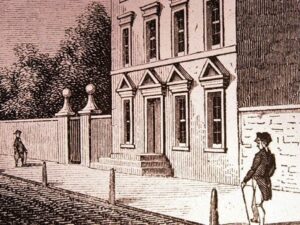 the power of bigotry and superstition.” He proclaimed November 26 as a day of Thanksgiving, always spending the day fasting and taking food to those in prison.
the power of bigotry and superstition.” He proclaimed November 26 as a day of Thanksgiving, always spending the day fasting and taking food to those in prison.
The president’s office was in New York for sixteen months; then moved to Philadelphia, where George and Martha lived from November 1790 to March 1797, before returning to their beloved Mount Vernon at the end of George’s presidency. On December 12, 1799, George inspected his farms on horseback in snow and sleet. He had a sore throat the following day but again went out in freezing, snowy weather to mark trees for cutting. Chest congestion and sore throat followed; he died swiftly on December 14, with Martha seated by his bed. He was 67. As word of his death traveled, church bells rang, businesses closed, and memorial processions were held in major cities. Martha wore a black mourning cape for a year.
George Washington’s legacy endures as one of the most influential in American history. He was called the “Father of His Country” as early as 1778. Congress proclaimed his birthday as a federal holiday in 1885. Many places and monuments have been named in honor of George Washington, most notably the nation’s capital, and the state of Washington. Twentieth-century biographer Douglas Freeman has stated: “The great big thing stamped across that man is character.” Historian David Fischer goes on to define that character as “integrity, self discipline, courage, absolute honesty, resolve, and decision; but also forbearance, decency, and respect for others.”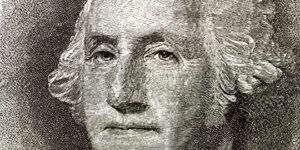
The mark for the leader of the United States was set high at the start. Which of the next 45 presidents measured up to that?
Which of those characteristics are important to you, as you cast your vote on November 5?
» posted on Tuesday, August 23rd, 2022 by Linda Lou Burton
Final Glide
Originally published August 16, 2020 by Linda Lou Burton posting about Washington, DC from Little Rock, Arkansas – This is it. Today is the end of the NDI RTW. Tonight, I sleep in my own bed after 40 days of almost non-stop travel. I wonder if Katy cat will even remember me. But this morning I woke up in Washington, DC with two of my grandchildren, and this reality: our flight to Little Rock, the  only DIRECT flight available (and I couldn’t bear going through Atlanta) didn’t depart until 6 PM. And the three of us were burnt out on DC sightseeing. So what could be better than a nice calm boat ride on the Potomac River to Mt Vernon? We were in agreement, up and packed and checked out by 8; at the Water Taxi dock in time to leave at 9.
only DIRECT flight available (and I couldn’t bear going through Atlanta) didn’t depart until 6 PM. And the three of us were burnt out on DC sightseeing. So what could be better than a nice calm boat ride on the Potomac River to Mt Vernon? We were in agreement, up and packed and checked out by 8; at the Water Taxi dock in time to leave at 9.
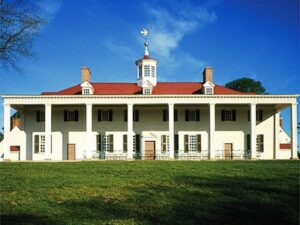 The trip was a pleasant ride, the Washington skyline, a stop in Alexandria, and then ashore by 10 at George Washington’s Mount Vernon Estate. “You just added Virginia to your state count,’” I told Kayla and Sam. We had four hours of our own time to wander; George and Martha’s home, their tomb, the farm and farm animals, a gristmill and distillery, the Mount Vernon Inn for lunch. Though there are a few museums there, we went to something called Be Washington, an
The trip was a pleasant ride, the Washington skyline, a stop in Alexandria, and then ashore by 10 at George Washington’s Mount Vernon Estate. “You just added Virginia to your state count,’” I told Kayla and Sam. We had four hours of our own time to wander; George and Martha’s home, their tomb, the farm and farm animals, a gristmill and distillery, the Mount Vernon Inn for lunch. Though there are a few museums there, we went to something called Be Washington, an 
 interactive movie theater. “Step into Washington’s shoes. What would YOU do? Your daring plan of crossing the Delaware River paid off with great military victories. As Commander In Chief, are you willing to do it again and risk your men’s lives? The Battle of Second Trenton, The Newburgh Conspiracy, The Genet Affair, The Whiskey Rebellion – all tests of your “presidential decision-making capacity.” That was entertaining!
interactive movie theater. “Step into Washington’s shoes. What would YOU do? Your daring plan of crossing the Delaware River paid off with great military victories. As Commander In Chief, are you willing to do it again and risk your men’s lives? The Battle of Second Trenton, The Newburgh Conspiracy, The Genet Affair, The Whiskey Rebellion – all tests of your “presidential decision-making capacity.” That was entertaining!
 Back at the DC dock at 3:30; a taxi to Reagan Airport, and now we’re flying. Will everything happen that we’re expecting? Kayla’s Dad Rick has been at my house all week, cat-sitting Katy and, I hope, spiffing things up and laying groceries in; that was part of the deal. Sam’s Dad Scott flew in yesterday; my oldest son Mike, and Brenda, picked him up at the airport as they arrived by car from Colorado, so the four of them have had an evening together. Did they make banners? Did they buy balloons? I just trekked around the world at age 81. I want adulation, and cheers! At the least a hand sparkler or two.
Back at the DC dock at 3:30; a taxi to Reagan Airport, and now we’re flying. Will everything happen that we’re expecting? Kayla’s Dad Rick has been at my house all week, cat-sitting Katy and, I hope, spiffing things up and laying groceries in; that was part of the deal. Sam’s Dad Scott flew in yesterday; my oldest son Mike, and Brenda, picked him up at the airport as they arrived by car from Colorado, so the four of them have had an evening together. Did they make banners? Did they buy balloons? I just trekked around the world at age 81. I want adulation, and cheers! At the least a hand sparkler or two.
I think we’re over Tennessee now. Sam and Kayla have nodded off. We are all exhausted.
I’m ready to be home.
» posted on Saturday, January 16th, 2021 by Linda Lou Burton
Basic – The Constitution
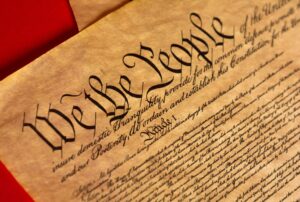 Posted from the capital city of Little Rock, Arkansas by Linda Lou Burton – For $19.95 you can order a facsimile of the Constitution of the United States as it was originally written, way back in 1787. Not kidding – the folks at the National Archives have gone to the trouble of printing all four pages in a 23 x 28 size, on paper that is crinkled and aged in appearance. Go to their store at if you want to see it as it was handwritten, and signed. If you have trouble reading the flourishing script, get yourself a copy of the transcribed version. Or go digital. https://www.archives.gov/founding-docs/constitution-transcript
Posted from the capital city of Little Rock, Arkansas by Linda Lou Burton – For $19.95 you can order a facsimile of the Constitution of the United States as it was originally written, way back in 1787. Not kidding – the folks at the National Archives have gone to the trouble of printing all four pages in a 23 x 28 size, on paper that is crinkled and aged in appearance. Go to their store at if you want to see it as it was handwritten, and signed. If you have trouble reading the flourishing script, get yourself a copy of the transcribed version. Or go digital. https://www.archives.gov/founding-docs/constitution-transcript
The point is – if you live, and work, and play, and sleep, and eat, in the United States, it’s vital that you understand just what that means with regard to your responsibilities, and your privileges. So start by reading the Constitution.
The United States Constitution consists of a Preamble and seven Articles, addressing the idea of a country of united states (there were 13 at the time), and providing directions for how it would work; a “recipe” for a new country. It was created and presented in September 1787 by 55 men representing the states of:
- Connecticut
- Delaware
- Georgia
- Maryland
- Massachusetts
- New Hampshire
- New Jersey
- New York
- North Carolina
- Pennsylvania
- South Carolina
- Virginia
Note: Rhode Island declined to send delegates.
The Preamble
 We the People of the United States, in Order to form a more perfect Union, establish Justice, insure domestic Tranquility, provide for the common defence, promote the general Welfare, and secure the Blessings of Liberty to ourselves and our Posterity, do ordain and establish this Constitution for the United States of America.
We the People of the United States, in Order to form a more perfect Union, establish Justice, insure domestic Tranquility, provide for the common defence, promote the general Welfare, and secure the Blessings of Liberty to ourselves and our Posterity, do ordain and establish this Constitution for the United States of America.
Article I – Legislative
All legislative Powers herein granted shall be vested in a Congress of the United States, which shall consist of a Senate and House of Representatives.
Sections 2-10 describe the scope and limits of these powers, and specify the who, what, and when for election of a person to legislative office.
Article II -Executive
The executive Power shall be vested in a President of the United States of America. He shall hold his Office during the Term of four Years, and, together with the Vice President, chosen for the same Term, be elected, as follows:
Each State shall appoint, in such Manner as the Legislature thereof may direct, a Number of Electors, equal to the whole Number of Senators and Representatives to which the State may be entitled in the Congress: but no Senator or Representative, or Person holding an Office of Trust or Profit under the United States, shall be appointed an Elector.
Sections 2 and 3 outline the duties, responsibilities, and powers of an elected president and Section 4 addresses the removal of an elected president.
Section 4.
The President, Vice President and all civil Officers of the United States, shall be removed from Office on Impeachment for, and Conviction of, Treason, Bribery, or other high Crimes and Misdemeanors.
Article III – Judicial
The judicial Power of the United States, shall be vested in one supreme Court, and in such inferior Courts as the Congress may from time to time ordain and establish. The Judges, both of the supreme and inferior Courts, shall hold their Offices during good Behaviour, and shall, at stated Times, receive for their Services, a Compensation, which shall not be diminished during their Continuance in Office.
Sections 2 and 3 further outline the duties, responsibilities, and powers of the United States judiciary.
Article IV – States and Citizens
Full Faith and Credit shall be given in each State to the public Acts, Records, and judicial Proceedings of every other State. And the Congress may by general Laws prescribe the Manner in which such Acts, Records and Proceedings shall be proved, and the Effect thereof.
Section 2.
The Citizens of each State shall be entitled to all Privileges and Immunities of Citizens in the several States. A Person charged in any State with Treason, Felony, or other Crime, who shall flee from Justice, and be found in another State, shall on Demand of the executive Authority of the State from which he fled, be delivered up, to be removed to the State having Jurisdiction of the Crime.
Sections 3 and 4 outline the admission of new states, and the protections for each state.
Article V – Amendments
Provisions made for amendments to the Constitution as deemed necessary and appropriate.
Article VI – Debts and Oaths
The Senators and Representatives before mentioned, and the Members of the several State Legislatures, and all executive and judicial Officers, both of the United States and of the several States, shall be bound by Oath or Affirmation, to support this Constitution; but no religious Test shall ever be required as a Qualification to any Office or public Trust under the United States.
Article VII – Ratification
The Ratification of the Conventions of nine States, shall be sufficient for the Establishment of this Constitution between the States so ratifying the Same.
What Happened Next
 Only 39 men actually signed the Constitution, which illustrates just how hard a task it was to get agreement on this “never done before” undertaking. It was crafted by men representing very different interests and views, who cared enough to come together and, after three hot summer months of thrashing out ideas, move forward in compromise. The delegates ranged in age from Jonathan Dayton, aged 26, to Benjamin Franklin, aged 81, who was so infirm that he had to be carried to sessions. Five states – Delaware, Pennsylvania, New Jersey, Georgia, and Connecticut – ratified the Constitution quickly; followed by Maryland and South Carolina; the ninth state to ratify was New Hampshire. It was agreed that the Constitution would go into effect March 4, 1789. Virginia, New York, North Carolina, and Rhode Island were the last four states to complete the ratification process, by May of 1790.
Only 39 men actually signed the Constitution, which illustrates just how hard a task it was to get agreement on this “never done before” undertaking. It was crafted by men representing very different interests and views, who cared enough to come together and, after three hot summer months of thrashing out ideas, move forward in compromise. The delegates ranged in age from Jonathan Dayton, aged 26, to Benjamin Franklin, aged 81, who was so infirm that he had to be carried to sessions. Five states – Delaware, Pennsylvania, New Jersey, Georgia, and Connecticut – ratified the Constitution quickly; followed by Maryland and South Carolina; the ninth state to ratify was New Hampshire. It was agreed that the Constitution would go into effect March 4, 1789. Virginia, New York, North Carolina, and Rhode Island were the last four states to complete the ratification process, by May of 1790.
Today the United States Constitution is the oldest written constitution in operation in the world. It consists of 4,543 words. Check out that original, the beginnings of the framework of the United States.
Give it a read. It’s a basic.
A BONUS – The National Archives not only offers you the opportunity to see that document and all those signatures, beginning with George Washington’s, but allows you to add your digital signature! https://www.archives.gov/founding-docs/join-the-signers
Footnote: Jacob Shallus was the “engrosser” who penned the document on four sheets of parchment made from treated animal skin (the conservator at the Archives says it was either calf, goat, or sheep skin). He used a goose quill with ink made of iron filings in oak gall. It started out black, but has aged to a brown color. Jacob, who was 37 at the time, was paid $30 for his work; he was Assistant Clerk to the Pennsylvania Assembly at the time, so likely was chosen for the job due to the Convention’s desire for speedy drafting; he was there and available to do the job. His name appears nowhere on the document.
Upcoming posts: Amendments, Growth, Changes
Tomorrow: The Oaths
» posted on Tuesday, July 7th, 2020 by Linda Lou Burton
Count Me!
 Linda Lou Burton posting from Little Rock, Arkansas – I’m signed up for regular updates from the U S Census Bureau because I love anything that gives me facts and figures to analyze. And as a dedicated student of family history, I rely heavily on Census records to “follow footsteps through time.” I was delighted a few years back when the Census was released that first had MY name on it! I was verified. There is something very satisfying about being counted. And 2020 is time to do it again.
Linda Lou Burton posting from Little Rock, Arkansas – I’m signed up for regular updates from the U S Census Bureau because I love anything that gives me facts and figures to analyze. And as a dedicated student of family history, I rely heavily on Census records to “follow footsteps through time.” I was delighted a few years back when the Census was released that first had MY name on it! I was verified. There is something very satisfying about being counted. And 2020 is time to do it again.
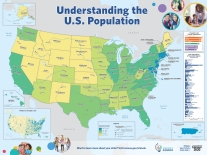 As you may know, every 10 years the United States counts its population. It’s a requirement, written into the Constitution. And the first count dates back to our first president, when U S Marshals conducted the census on horseback. It’s happened once a decade since then, as the country has continued to grow, and changes in our laws, our cultural norms and our attitudes have changed the focus of information gathered, and questions asked, in an effort to make sure everyone is counted.
As you may know, every 10 years the United States counts its population. It’s a requirement, written into the Constitution. And the first count dates back to our first president, when U S Marshals conducted the census on horseback. It’s happened once a decade since then, as the country has continued to grow, and changes in our laws, our cultural norms and our attitudes have changed the focus of information gathered, and questions asked, in an effort to make sure everyone is counted.
1790
The very first U S Census was conducted a year after George Washington took office. Every household in the original 13 states was visited, plus the districts of Kentucky, Maine, Vermont, and the Southwest Territory. The inquiries called for the name of the head of household, and the number of persons living in the household, as described:
- Free white male of 16 years and up (to assess the country’s industrial and military potential)
- Free white males under 16
- Free white females
- Slaves
The count according to that first census as of August 2, 1790 was 3,929,214.
1850
It was 1850 when the inquiries expanded to include every free person’s name, not just the head of household. Relationships were not listed, just names and ages, but additional “social statistics” included information on taxes, schools, crime, wages, and value of the estate.
Zachary Taylor was President of the United States on Census Day June 1, 1850. The U S had grown to 30 states by then, with a population count of 23,191,876.
1870
Census Day was June 1 in 1870 and Ulysses S Grant was President of our 37 United States.
After the Civil War, the decennial census questionnaires were redesigned to end the slave questionnaire. The schedules for the 1870 census were: General Population, Mortality, Agriculture, Products of Industry, and Social Statistics.
This was the first year a rudimentary tallying machine helped with the count, which added up to 38,558,371.
1880
Census Day was June 1 in 1880 and Rutherford B. Hayes was President of our 38 United States.
This census is a genealogists dream, because for the first time, relationships to “head of household” are listed: wife, son, daughter, and such things as lodger, or servant. Information about Alaska was included in this census, as well as all untaxed Indians within the jurisdiction of the United States.
The count in 1880 was 50,189,209.
1920
Census Day was January 1 in 1920 (more people would be at home in January, was the theory, than during the busy summertime) and Woodrow Wilson was President of our 48 states.
The format no longer asked about service in the Union or Confederate army or navy and there was no separate schedule for Indians in 1920. The instructions to enumerators did not require that individuals spell out their names. Enumerators wrote down the information given to them; they were not authorized to request proof of age, and the determination of race was based on the enumerator’s impressions.
Can you guess what our population count was a hundred years ago? 106,021,537!
2020
What will our 24th U S Census reveal?
 The 2020 Census counts every person living in the United States and five U S territories, Puerto Rico, American Samoa, the Commonwealth of the Northern Mariana Islands, Guam, and the U S Virgin Islands. Each home received an invitation to respond to a short questionnaire—online, by phone, or by mail—between March 12-20. No horseback! House calls only as necessary or requested.
The 2020 Census counts every person living in the United States and five U S territories, Puerto Rico, American Samoa, the Commonwealth of the Northern Mariana Islands, Guam, and the U S Virgin Islands. Each home received an invitation to respond to a short questionnaire—online, by phone, or by mail—between March 12-20. No horseback! House calls only as necessary or requested.
Why is it so important to respond?
The census provides critical data that lawmakers, business owners, teachers, and many others use to provide daily services, products, and support for you and your community. Every year, billions of dollars in federal funding go to hospitals, fire departments, schools, roads, and other resources based on census data. The results of the census also determine the number of seats each state will have in the U S House of Representatives, and they are used to draw congressional and state legislative districts.
The Census Bureau will never ask for your:
- Social Security number.
- Money or donations.
- Anything on behalf of a political party.
- Bank or credit card account numbers.
Additionally, there is no citizenship question on the 2020 Census.
If you haven’t responded yet, you can do so online, go here.
https://2020census.gov/en/what-is-2020-census.html
And for a little fun, test your knowledge of census history with this quiz. I did, and (brag, brag) I answered every question correctly. Hint: read the third paragraph of this post and you’ll ace the first question.
https://2020census.gov/en/what-is-2020-census/focus/history-quiz.html
» posted on Saturday, December 7th, 2013 by Linda Lou Burton
The Soup Bowl
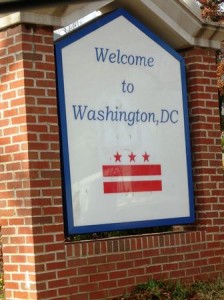 Linda Burton posting from Washington, DC – I call it “DC.” When I lived in Seattle if you said “Washington” folks thought you were referring to the state; Washington DC is considered the “other Washington” there. But I’m on the east coast today, easing into “the District” from Maryland and headed for the US Capitol, an icing-on-the cake post-stop in the Journey Across America. The majestic dome loomed tall as I approached; I circled in confusion and landed a parking spot on the other side. The Washington Monument was a few blocks to my right, covered in scaffolding due to earthquake repair. I coaxed the cats to the window to
Linda Burton posting from Washington, DC – I call it “DC.” When I lived in Seattle if you said “Washington” folks thought you were referring to the state; Washington DC is considered the “other Washington” there. But I’m on the east coast today, easing into “the District” from Maryland and headed for the US Capitol, an icing-on-the cake post-stop in the Journey Across America. The majestic dome loomed tall as I approached; I circled in confusion and landed a parking spot on the other side. The Washington Monument was a few blocks to my right, covered in scaffolding due to earthquake repair. I coaxed the cats to the window to 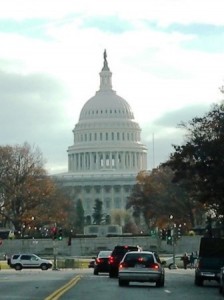 look; then tied my red wool scarf tight around my head before stepping out into the wind. Not a day for sightseeing. But people were out; a Chinese chorus was performing across the street; cameras were in evidence in every hand. Washington, DC! What is so special about this place? Why do 19 million visitors come every year? It’s exciting, and vibrant, that’s why; a bubbling soup bowl brimming with a little bit of everything. The resident population is 601,723 (US Census 2010), but that jumps to a million throughout the workweek; commuters pour in from the suburbs of Maryland and Virginia. After all, the centers of all three branches of the federal government are
look; then tied my red wool scarf tight around my head before stepping out into the wind. Not a day for sightseeing. But people were out; a Chinese chorus was performing across the street; cameras were in evidence in every hand. Washington, DC! What is so special about this place? Why do 19 million visitors come every year? It’s exciting, and vibrant, that’s why; a bubbling soup bowl brimming with a little bit of everything. The resident population is 601,723 (US Census 2010), but that jumps to a million throughout the workweek; commuters pour in from the suburbs of Maryland and Virginia. After all, the centers of all three branches of the federal government are 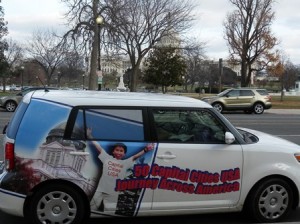 here – the Congress, the President, and the Supreme Court. Flags from all over the world fly here; count 176 foreign embassies. The headquarters of international organizations, trade unions, non-profits, and lobbying groups are here. There are more museums here than you could visit in a year; 19 within the Smithsonian alone. The architecture, park spaces, and memorials are stunning. You’ll find both inspiration and controversy here; it’s all in the soup. » read more
here – the Congress, the President, and the Supreme Court. Flags from all over the world fly here; count 176 foreign embassies. The headquarters of international organizations, trade unions, non-profits, and lobbying groups are here. There are more museums here than you could visit in a year; 19 within the Smithsonian alone. The architecture, park spaces, and memorials are stunning. You’ll find both inspiration and controversy here; it’s all in the soup. » read more
» posted on Friday, December 6th, 2013 by Linda Lou Burton
Staying Alive And The Final Five
 Linda Burton posting from Annapolis, Maryland – Psychologically we love countdowns. We count down the twelve days till Christmas. We countdown rocket launches, till we arrive at blastoff, or the mission is scrubbed. We countdown the Final Four in basketball every spring, when the world of college sports reaches fever pitch. I counted down the days in the month before my 16th birthday; I was on pins and needles to get my driver license; something everyone in my little town did back in the 50s when all the cars had fins and all the girls wore bobby socks. The year I went to Antarctica – that was 2005 – I counted off the weeks till my Seattle departure at Pagliacci Pizza. I happened to go for a Friday
Linda Burton posting from Annapolis, Maryland – Psychologically we love countdowns. We count down the twelve days till Christmas. We countdown rocket launches, till we arrive at blastoff, or the mission is scrubbed. We countdown the Final Four in basketball every spring, when the world of college sports reaches fever pitch. I counted down the days in the month before my 16th birthday; I was on pins and needles to get my driver license; something everyone in my little town did back in the 50s when all the cars had fins and all the girls wore bobby socks. The year I went to Antarctica – that was 2005 – I counted off the weeks till my Seattle departure at Pagliacci Pizza. I happened to go for a Friday  night pizza at the 17-week point and noticed they had 17 pizzas on their menu. “Aha,” I thought, “if I begin with the Original, when I get to the Verde Primo it will be time to fly to South America.” I called for grandson help on big-meat pizza nights; Matthew for Spicy Pepperoni; Andrew for Extra Pepperoni; both of them on Grand Salami Primo night. The AGOG was my favorite – mushrooms, roasted garlic, Kalamata olives, goat cheese, Fontina, Mozzarella and parsley over olive oil; fresh tomato slices added after the bake. The journey through the Pagliacci menu
night pizza at the 17-week point and noticed they had 17 pizzas on their menu. “Aha,” I thought, “if I begin with the Original, when I get to the Verde Primo it will be time to fly to South America.” I called for grandson help on big-meat pizza nights; Matthew for Spicy Pepperoni; Andrew for Extra Pepperoni; both of them on Grand Salami Primo night. The AGOG was my favorite – mushrooms, roasted garlic, Kalamata olives, goat cheese, Fontina, Mozzarella and parsley over olive oil; fresh tomato slices added after the bake. The journey through the Pagliacci menu  was an experience; I developed new tastes, and learned some things I didn’t know before. I dealt with whatever came next; I adapted as needed. You know where I’m going with that thought. Annapolis finishes the countdown through the Final Five; the Journey Across America is 100% complete. This mission wasn’t scrubbed; we made it all the way (adapting as needed) – the Scion, the cats, and me. We’re travelworn and frazzled, but completely AGOG with success. » read more
was an experience; I developed new tastes, and learned some things I didn’t know before. I dealt with whatever came next; I adapted as needed. You know where I’m going with that thought. Annapolis finishes the countdown through the Final Five; the Journey Across America is 100% complete. This mission wasn’t scrubbed; we made it all the way (adapting as needed) – the Scion, the cats, and me. We’re travelworn and frazzled, but completely AGOG with success. » read more
» posted on Friday, November 29th, 2013 by Linda Lou Burton
By George
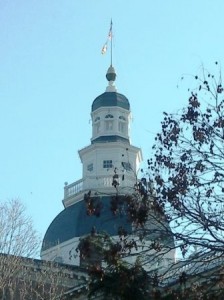 Linda Burton posting from Annapolis, Maryland – Before you read this post, look at the column to the right. On the dark blue background is a list of capital cities. Count them. You will find 50 capital cities listed now, because at 2:26 PM today, the cats and I arrived in Annapolis, capital city #50 on the Journey Across America. By George, we made it! I parked in front of the Robert Johnson building on the tight little circle street that surrounds the Maryland State House, and jumped out to record the moment with pictures. When I got back Jack was sitting on top of his carrier,
Linda Burton posting from Annapolis, Maryland – Before you read this post, look at the column to the right. On the dark blue background is a list of capital cities. Count them. You will find 50 capital cities listed now, because at 2:26 PM today, the cats and I arrived in Annapolis, capital city #50 on the Journey Across America. By George, we made it! I parked in front of the Robert Johnson building on the tight little circle street that surrounds the Maryland State House, and jumped out to record the moment with pictures. When I got back Jack was sitting on top of his carrier, 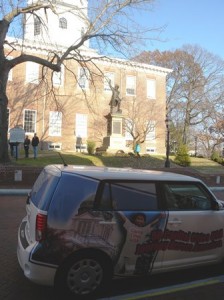 watching people walk by on the sidewalks of Annapolis; Alex was perched like a king on his pillow, unimpressed. “Do you think you’re King George?” I laughed. “You don’t want to acknowledge the feisty colonists?” It felt as though King George could be lurking around the corner; if, that is, King George had ever left England, and, if there weren’t so many 21st-century automobiles crowding the narrow brick-paved streets. We were in what is officially named the “Colonial Annapolis Historic District,” where 18th-century buildings remain much as they were when built. To my left the Maryland State House occupies the city’s highest hill; from that point all streets radiate outward; dropping down towards the
watching people walk by on the sidewalks of Annapolis; Alex was perched like a king on his pillow, unimpressed. “Do you think you’re King George?” I laughed. “You don’t want to acknowledge the feisty colonists?” It felt as though King George could be lurking around the corner; if, that is, King George had ever left England, and, if there weren’t so many 21st-century automobiles crowding the narrow brick-paved streets. We were in what is officially named the “Colonial Annapolis Historic District,” where 18th-century buildings remain much as they were when built. To my left the Maryland State House occupies the city’s highest hill; from that point all streets radiate outward; dropping down towards the 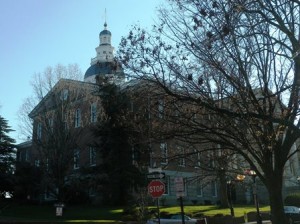 waterfront; leading in the other direction towards the countryside. One thing is clear; when this city was laid out, it was intended that all roads lead to the focal point of government – the Maryland State House, the “oldest in the nation still in legislative use” as it so proudly claims. And here the presence of our most beloved “George” remains – George Washington, of course. “This is a living history book,” I said to the cats. “It comes together here.” » read more
waterfront; leading in the other direction towards the countryside. One thing is clear; when this city was laid out, it was intended that all roads lead to the focal point of government – the Maryland State House, the “oldest in the nation still in legislative use” as it so proudly claims. And here the presence of our most beloved “George” remains – George Washington, of course. “This is a living history book,” I said to the cats. “It comes together here.” » read more
» posted on Friday, March 15th, 2013 by Linda Lou Burton
Sophisticated Simplicity
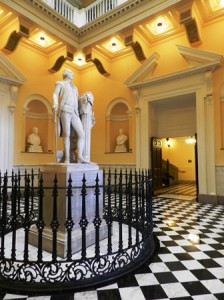 Linda Burton posting from Richmond, Virginia – If you want to know what George Washington really looked like, go to the Virginia state capitol. Centered in the rotunda against the simplicity of a formal backdrop of black and white stands a life-size statue of Washington, considered by his contemporaries to be “a perfect likeness.” It was June 1784 when the Virginia General Assembly commissioned the statue to be made; Thomas Jefferson, on a diplomatic mission in France, secured the services of French artist Jean-Antoine Houdon for the work. Houdon didn’t guess at his task; in the fall of 1785 he traveled to Mount Vernon to study his subject. He made a plaster mask of Washington’s head and took detailed measurements of his body; from this he modeled a terra cotta bust to take back to his workshop in France.
Linda Burton posting from Richmond, Virginia – If you want to know what George Washington really looked like, go to the Virginia state capitol. Centered in the rotunda against the simplicity of a formal backdrop of black and white stands a life-size statue of Washington, considered by his contemporaries to be “a perfect likeness.” It was June 1784 when the Virginia General Assembly commissioned the statue to be made; Thomas Jefferson, on a diplomatic mission in France, secured the services of French artist Jean-Antoine Houdon for the work. Houdon didn’t guess at his task; in the fall of 1785 he traveled to Mount Vernon to study his subject. He made a plaster mask of Washington’s head and took detailed measurements of his body; from this he modeled a terra cotta bust to take back to his workshop in France. 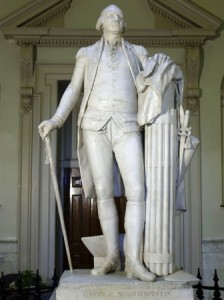 The resulting statue, carved of Carrara marble, was shipped to America in 1796 and has graced the capitol’s rotunda since. It is considered to be Virginia’s greatest treasure and one of the world’s finest portrait sculptures; it is the only full-length statue for which the first President posed. Although Washington’s sword is by his side and he wears his Revolutionary uniform, he
The resulting statue, carved of Carrara marble, was shipped to America in 1796 and has graced the capitol’s rotunda since. It is considered to be Virginia’s greatest treasure and one of the world’s finest portrait sculptures; it is the only full-length statue for which the first President posed. Although Washington’s sword is by his side and he wears his Revolutionary uniform, he 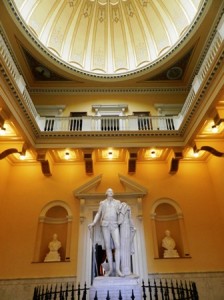 carries a civilian walking cane and stands over a plough; Houdon sought to show the balance between Washington’s life as a soldier, statesman, and private citizen. In the niches of the rotunda are busts of other Virginia-born presidents who succeeded Washington – Jefferson, Madison, Monroe, Harrison, Tyler, Taylor, and Wilson – and another work by Houdon; that of LaFayette, the French citizen who was a Major General in service to the United States during the Revolutionary War. But more about the rotunda itself, a magnificent two-story space capped by a dome; a dome that is invisible from the outside. » read more
carries a civilian walking cane and stands over a plough; Houdon sought to show the balance between Washington’s life as a soldier, statesman, and private citizen. In the niches of the rotunda are busts of other Virginia-born presidents who succeeded Washington – Jefferson, Madison, Monroe, Harrison, Tyler, Taylor, and Wilson – and another work by Houdon; that of LaFayette, the French citizen who was a Major General in service to the United States during the Revolutionary War. But more about the rotunda itself, a magnificent two-story space capped by a dome; a dome that is invisible from the outside. » read more
» posted on Sunday, March 3rd, 2013 by Linda Lou Burton
Sunday in the Park with George
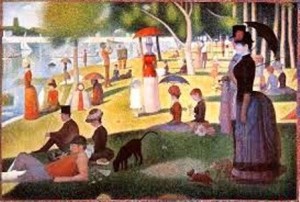 Linda Burton posting from Raleigh, North Carolina – Stephen Sondheim (b 1930) is an accomplished American composer best known for his contributions to musical theater. In 1984 he and James Lapine put together a Broadway production called Sunday in the Park with George. It opened to mixed reviews, but in the end, wound up winning a Pulitzer Prize for drama, two Tony Awards for design, the 1991 Olivier Award for Best Musical, and the 2007 Olivier Award for Outstanding Musical Production. The play was inspired by a painting called A Sunday Afternoon on the Island of La Grande Jatte, done by George Seurat (1859-1891), a French Post-Impressionist painter. It took George two years to complete this 10-foot-wide piece that shows members of different social classes participating in various
Linda Burton posting from Raleigh, North Carolina – Stephen Sondheim (b 1930) is an accomplished American composer best known for his contributions to musical theater. In 1984 he and James Lapine put together a Broadway production called Sunday in the Park with George. It opened to mixed reviews, but in the end, wound up winning a Pulitzer Prize for drama, two Tony Awards for design, the 1991 Olivier Award for Best Musical, and the 2007 Olivier Award for Outstanding Musical Production. The play was inspired by a painting called A Sunday Afternoon on the Island of La Grande Jatte, done by George Seurat (1859-1891), a French Post-Impressionist painter. It took George two years to complete this 10-foot-wide piece that shows members of different social classes participating in various 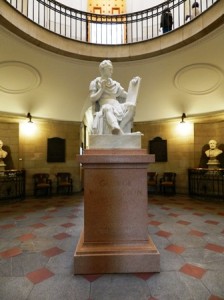 park activities on a Sunday afternoon; he devised an innovative technique for it called “pointillism,” using tiny juxtaposed dots of color, rather than physically blending the colors on canvas. Very different in its day, and as you might guess, the painting “opened to mixed reviews;” today however it is recognized as a work that altered the direction of modern art. So what does this have to do with Raleigh, North Carolina? I’m about to tell you the story of Antonio Canova (1757-1822), an Italian sculptor, and the controversial statue he did of George Washington (1732-1799) that sits in the rotunda of the North Carolina capitol today. It wasn’t meant to be controversial, of course, and what you see today isn’t what Canova did in 1820; but, well, I’d better start from the beginning to explain. » read more
park activities on a Sunday afternoon; he devised an innovative technique for it called “pointillism,” using tiny juxtaposed dots of color, rather than physically blending the colors on canvas. Very different in its day, and as you might guess, the painting “opened to mixed reviews;” today however it is recognized as a work that altered the direction of modern art. So what does this have to do with Raleigh, North Carolina? I’m about to tell you the story of Antonio Canova (1757-1822), an Italian sculptor, and the controversial statue he did of George Washington (1732-1799) that sits in the rotunda of the North Carolina capitol today. It wasn’t meant to be controversial, of course, and what you see today isn’t what Canova did in 1820; but, well, I’d better start from the beginning to explain. » read more
» posted on Sunday, July 29th, 2012 by Linda Lou Burton
Uncles and Aunts
Linda Burton posting from Edmonds, Washington while traveling between Juneau, Alaska and Helena, Montana – This post is a bit of a stretch, capital-city wise. But I am in Washington state and it is the only state named after a president (although we know for sure George Washington never slept here!). I was thinking about George’s relatives today, because I spent the afternoon with some of mine. With all the stories I have heard about our first president, I never learned about his relatives. Did he have any kids? Or nieces and nephews? A little research tonight led me to the answer; turns out George has often been referred to as “First Uncle.” George didn’t have any children of his own, but he was step-father to Martha Dandridge Custis’ two children, Jacky and Patsy, only four and two when George and Martha married. George had two half-brothers, three brothers, and a sister; he wound up with a number of nieces and nephews too. And since George outlived all his siblings, it follows that he wound up with responsibilities towards their children. » read more

